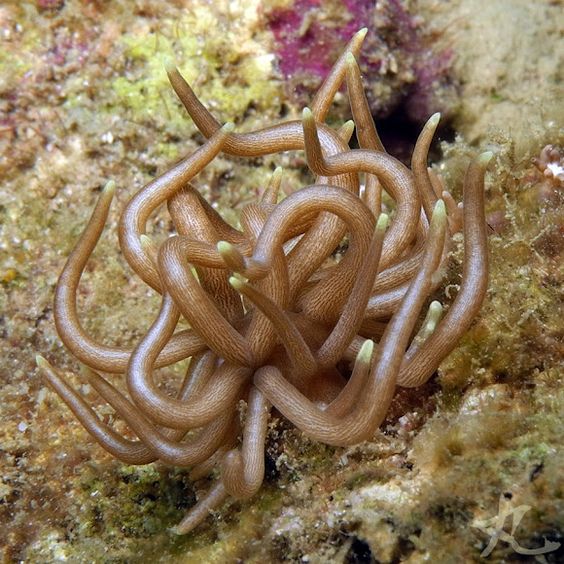
This solar-powered slug is the Medusa of the nudibranchs. Its long tentacle-like features have a large flat surface that is covered in Zoocanthellae brown algae and separated into individual ‘solar panels’. It farms algae on its body to create energy through photosynthesis, which means it uses the ability of plants to convert the sun’s energy into sugars and nutrients. Over time, this particular nudi has greatly modified the shape of its body to provide as many sunlit regions as possible for their ‘veggie patch’ to photosynthesize.

This little slug enjoys feeding on leather coral, especially the type that produces toxic compounds so that it can store the poison to produce a bad taste for potential predators.
If you want to see this slug, it can be located in the dream dive destinations of Raja Ampat, Indonesia which has the reputation of having the greatest diversity of marine life on earth.
Gill Divers organize safe and stress-free trips to Raja Ampat and other locations. Email us on [email protected] for more details.
Information on Raja Ampat is located on our website.

Wow, I’ve never seen anything like this before! The idea of a slug farming algae on its body to generate energy is just mind-blowing. It’s amazing how these creatures have adapted to their environment in such creative ways.
Hi Aisha, Thank you for sharing your thoughts about our blog post on the solar-powered slug! We’re thrilled that you found it mind-blowing and amazing. At Gill Divers, we’re passionate about sharing the wonders of marine life with others. If you have any questions or would like to learn more about these incredible creatures, please don’t hesitate to contact us at [email protected]. We’d be happy to help you plan a trip to Raja Ampat and explore this fascinating ecosystem firsthand.
I’ve always been fascinated by the diversity of marine life, and this post just takes it to a whole new level. The fact that these slugs can store toxic compounds from their food is just incredible. Can’t wait to plan my next dive trip to Raja Ampat!
Wow, we’re thrilled that our post has sparked your interest in the fascinating world of marine life! The unique adaptations of these solar-powered nudibranchs are indeed incredible. We’re excited to hear that you’re planning a dive trip to Raja Ampat! Our team at Gill Divers would be delighted to help you plan an unforgettable experience. Feel free to reach out to us at [email protected] for more information and let’s get started on making your diving dreams come true!
As a nature lover, I’m always excited to learn about new species and how they adapt to their environments. This solar-powered slug is just one example of the incredible diversity we have in our oceans. Thanks for sharing this fascinating find!
Thank you for sharing your enthusiasm about our marine life! We’re thrilled to hear that you’re excited to learn about new species and their adaptations. Our solar-powered slug is indeed a fascinating find, and we’re glad we could share it with you. If you have any questions or would like to know more about our ocean friends, feel free to reach out to us at [email protected]. We’d be happy to help! And who knows, maybe one day you’ll join us on a dive trip to Raja Ampat and get up close and personal with these incredible creatures.